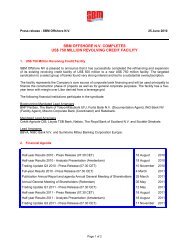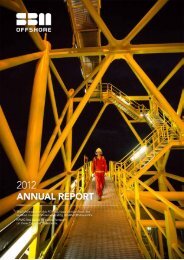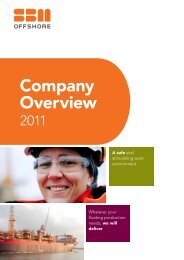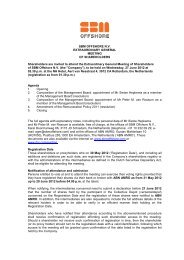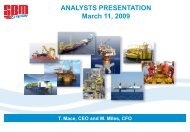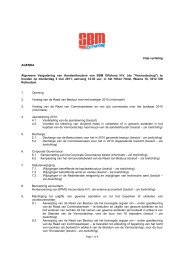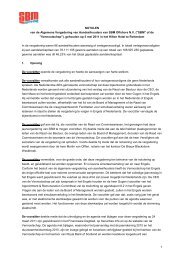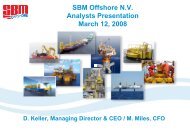Annual Report 2010 - SBM Offshore
Annual Report 2010 - SBM Offshore
Annual Report 2010 - SBM Offshore
Create successful ePaper yourself
Turn your PDF publications into a flip-book with our unique Google optimized e-Paper software.
Financial Review / Financial Statements <strong>2010</strong><br />
services and supply of special components and proprietary<br />
designs and equipment. The Turnkey Services<br />
segment derives its revenues from offshore contracting<br />
and after-sales services. The Lease and Operate<br />
segment comprises the total of earned day-rates on<br />
long-term operating lease and operate contracts. In the<br />
case of a finance lease, revenue is recognized during<br />
the construction period within the Turnkey Systems<br />
segment and, where installation activities are effected,<br />
within the Turnkey Services segment. As of the commencement<br />
date of the finance lease contract, the<br />
interest income is shown in the Lease and Operate<br />
segment.<br />
Management monitors the operating results of operating<br />
segments separately for the purpose of making<br />
decisions about resources to be allocated and for<br />
assessing performance. Segment performance is<br />
evaluated based on net result, which in certain respects<br />
is measured differently from operating profit or loss in<br />
the consolidated financial statements. Inter-segment<br />
revenues are made at prices that approximate market<br />
prices.<br />
Foreign currency translation<br />
Functional and reporting currency<br />
Items included in the financial statements of each of<br />
the Company’s entities are measured using the currency<br />
of the primary economic environment in which<br />
the entity operates (the ‘functional currency’). The<br />
functional currency of the offshore oil and gas activities<br />
is the US Dollar. The consolidated financial statements<br />
are presented in US Dollars, which is the reporting currency<br />
of the Company.<br />
Transactions and balances<br />
Foreign currency transactions are translated into the<br />
functional currency using the exchange rates prevailing<br />
at the dates of the transactions. Foreign exchange<br />
gains and losses resulting from the settlement of foreign<br />
currency transactions and from the translation<br />
at period end exchange rate of monetary assets and<br />
liabilities denominated in foreign currencies are recognised<br />
in the income statement, except when deferred<br />
in equity as qualifying cash flow hedges and qualifying<br />
net investment hedges.<br />
118 <strong>SBM</strong> <strong>Offshore</strong> – <strong>Annual</strong> <strong>Report</strong> <strong>2010</strong><br />
At year-end <strong>2010</strong> the most significant rate was the Euro<br />
at US$ 1.338 (opening <strong>2010</strong>: US$ 1.434). The average<br />
Euro rate amounted to US$ 1.3247 (2009: US$ 1.392).<br />
Group companies<br />
The result and financial position of all group companies<br />
that have a functional currency different from the<br />
reporting currency are translated into the reporting currency<br />
as follows:<br />
• assets and liabilities for each balance sheet presented<br />
are translated at the closing rate at the date<br />
of the balance sheet;<br />
• income and expenses are translated at the average<br />
exchange rate (unless this average rate is not a<br />
reasonable approximation of the cumulative effect<br />
of the rates prevailing on the transaction dates, in<br />
which case income and expenses are translated at<br />
the date of the transactions); and<br />
• all resulting exchange differences are recognised<br />
as a separate component of equity (Translation<br />
reserve).<br />
On consolidation exchange differences arising from<br />
the translation of the net investment in foreign entities,<br />
and of borrowings of such investments, are taken to<br />
Group equity. When an operation denominated in foreign<br />
currency is sold, such exchange differences are<br />
recognised in the income statement as part of the gain<br />
or loss on sale.<br />
Goodwill and fair value adjustments arising on the<br />
acquisition of a foreign entity are treated as assets and<br />
liabilities of the foreign entity and translated at the closing<br />
rate.<br />
Leases: Accounting by lessor<br />
A lease is an agreement whereby the lessor conveys<br />
to the lessee in return for a payment, or series of payments,<br />
the right to use an asset for an agreed period<br />
of time. Leases in which a significant portion of the risk<br />
and rewards of ownership are retained by the lessor are<br />
classified as operating leases.<br />
When assets are leased out under a finance lease, the<br />
present value of the lease payments is recognised as a<br />
receivable. The difference between the gross receivable<br />
and the present value of the receivable is recognised as<br />
unearned finance income.



